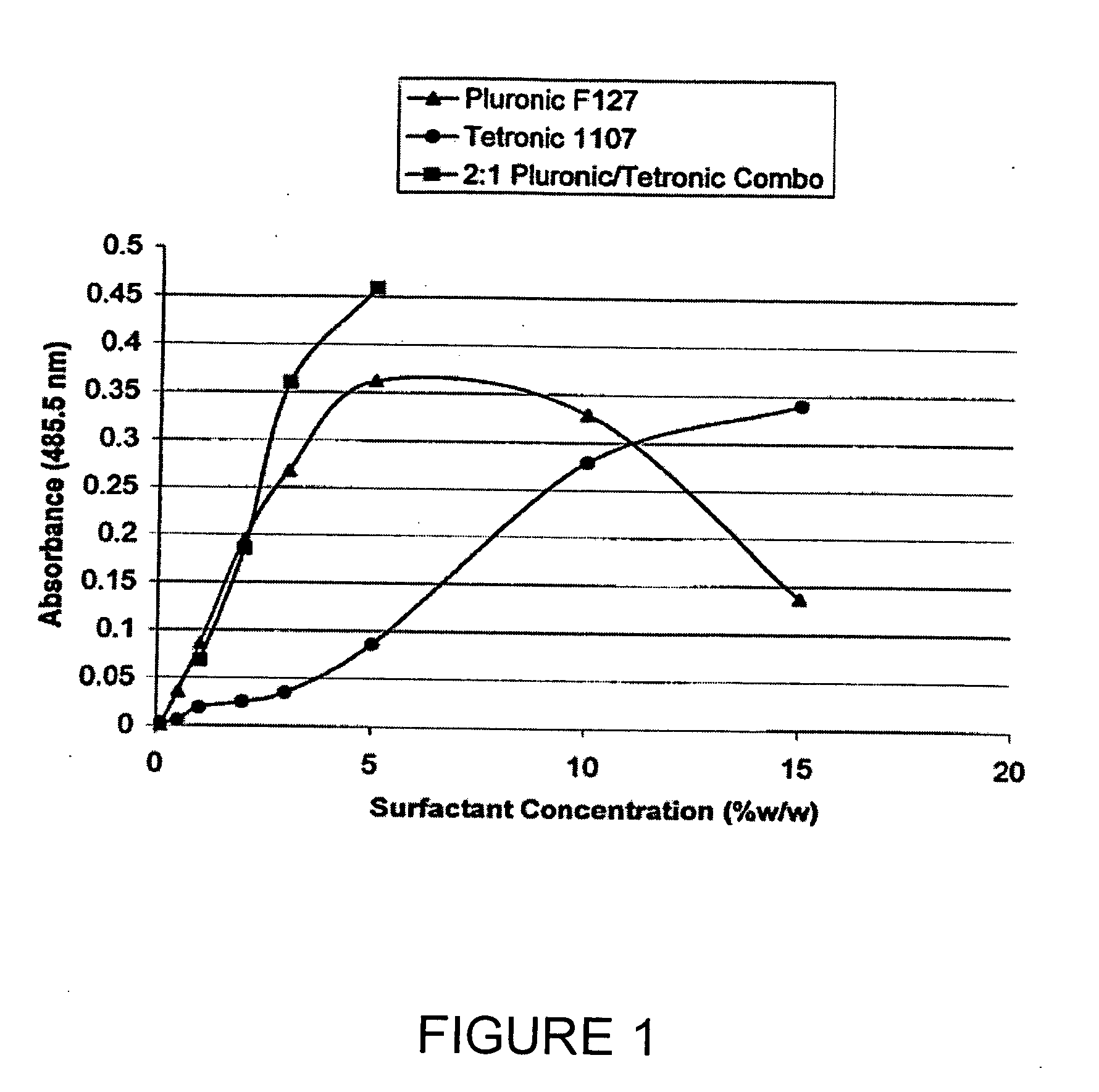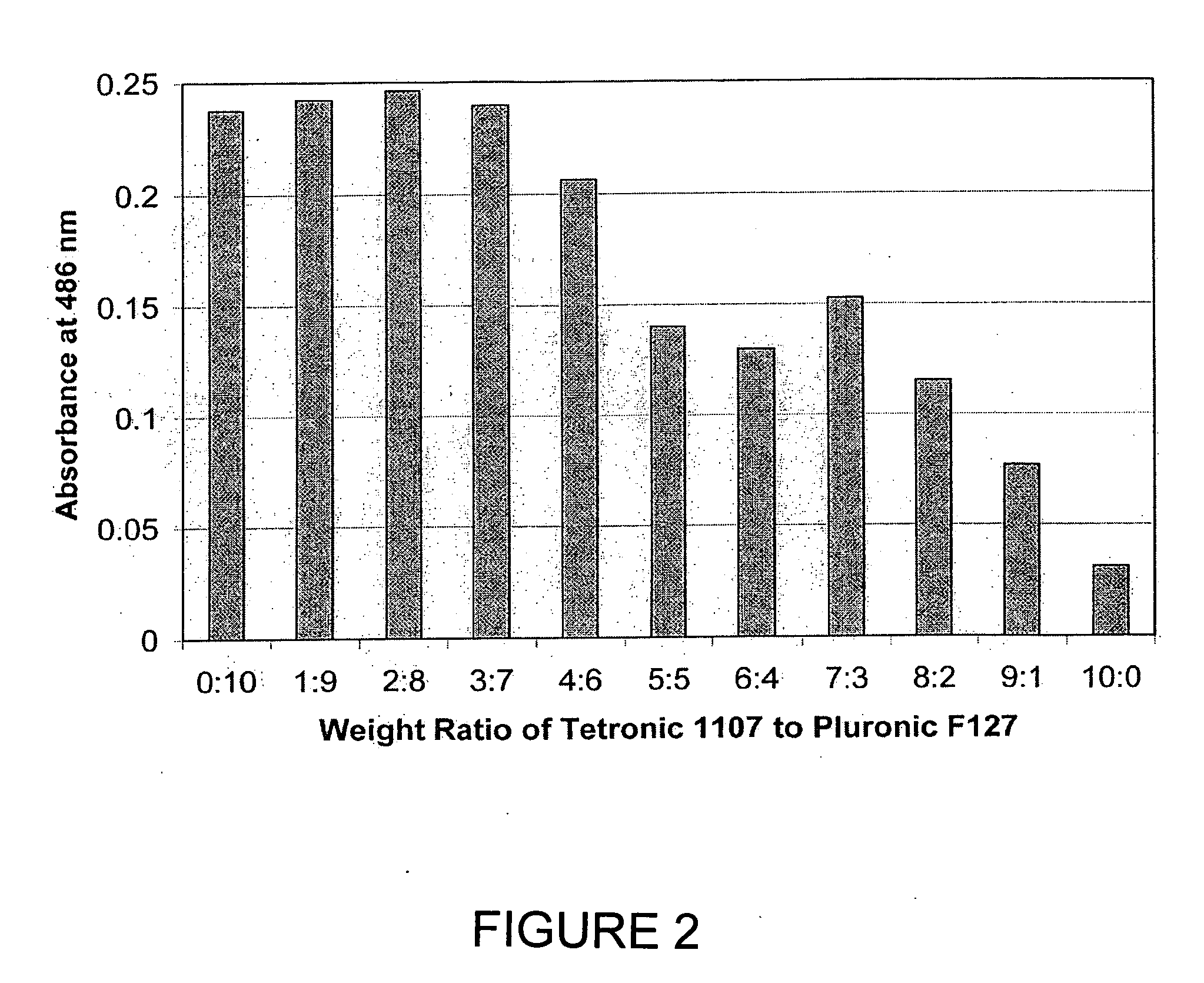Compositions for solubilizing lipids
a technology of lipids and compositions, applied in the field of relativity mild, can solve the problems of deterioration in the comfort of a lens, risk of eye irritation, blurred vision, etc., and achieve the effect of preventing the deposition of lipids
- Summary
- Abstract
- Description
- Claims
- Application Information
AI Technical Summary
Benefits of technology
Problems solved by technology
Method used
Image
Examples
example 1
Preparation of Test Solution
[0036] A multipurpose lens care sample solution for testing was prepared in accordance with the formulation set forth below in Table 1.
TABLE 1MULTIPURPOSE LENS CARE TEST SOLUTIONIngredients % W / WTest Solution 1Pluronic P1272.00Tetronic 11071.00Sodium Phosphate Monobasic0.15Sodium Phosphate Dibasic0.31Boric Acid0.85PHMB (ppm)1.1Sodium Chloride0.26Dequest ™ 2016 (30%)0.1Polyquaternium 100.02pH7.0Osmolality (mOsm / Kg)300
Dequest ™ 2016 = diphosphonic acid sodium salt
PHMB = poly(hexamethylene biguanide)
example 2
Preparation of Test Solution
[0037] A lens drops sample solution for testing was prepared in accordance with the formulation set forth below in Table 2.
TABLE 2LENS DROPS TEST SOLUTIONIngredients % W / WTest Solution 2Pluronic P1272.00Tetronic 11071.00Tromethamine0.121Sodium Borate0.134EDTA-Na0.05Glycerin1.0Sodium Chloride0.38Sorbic Acid0.165Polymer JR ™0.02pH7.0Osmolality (mOsm / Kg)305
EDTA = ethylenediamine tetraacetic acid
example 3
Cleaning Effect of Test Solutions
[0038] The cleaning effect of several test solutions over lipids was examined by means of a lipid-solubilizing rate method. Specifically, the lipids, C10-30 cholesterol / lanosterol esters, available under the trade name Super Sterol Ester™ from Croda Incorporated, Parsippany, N.J., and a dye material, available under the trade name Sudan I™ from Aldrich Chemical Company, Milwaukee, Wis., were used to produce a lipid solution used in determining the lipid cleaning efficacy of several test solutions. The lipid solution was produced by heating 9.9 grams of super sterol ester until melted. Once melted, 0.1 gram of Sudan I was added and mixed well. The mixture was a homogeneous red wax at room temperature that liquefied with slight heating. Into glass test tubes, five drops of liquefied lipid solution was placed making sure all drops coherently collected. Once the lipid solution in the test tubes cooled to room temperature, the tubes were ready for testin...
PUM
| Property | Measurement | Unit |
|---|---|---|
| weight percent | aaaaa | aaaaa |
| weight percent | aaaaa | aaaaa |
| weight ratio | aaaaa | aaaaa |
Abstract
Description
Claims
Application Information
 Login to View More
Login to View More - R&D
- Intellectual Property
- Life Sciences
- Materials
- Tech Scout
- Unparalleled Data Quality
- Higher Quality Content
- 60% Fewer Hallucinations
Browse by: Latest US Patents, China's latest patents, Technical Efficacy Thesaurus, Application Domain, Technology Topic, Popular Technical Reports.
© 2025 PatSnap. All rights reserved.Legal|Privacy policy|Modern Slavery Act Transparency Statement|Sitemap|About US| Contact US: help@patsnap.com


